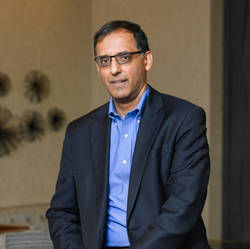
Respiratory
Development of Inhibitors that Prevent Lung Transplantation Rejection
2016 Harrington Scholar-Innovator
It's been more than half a century since James Hardy, MD, performed the first human lung transplant on a 58-year-old man in Jackson, Mississippi, and today doctors worldwide perform more than 2,000 lung transplants each year. Even with surgical advances, rigorous selection of patients and donors, and modern medical care, the average patient survives just five and a half years after transplant.
“Unlike other solid organ transplantation, half of lung transplant patients have chronic rejection,” notes Rama Mallampalli, MD, Division Chief of Pulmonary, Allergy and Critical Care Medicine at the University of Pittsburgh.
Intrigued by pulmonology since his fellowship at the University of Iowa, Dr. Mallampalli has a burning desire to develop an antirejection medicine more effective than prednisone and without the side effects. As a pulmonary consultant at the University of Pittsburgh Medical Center, his interactions with patients in intensive care are a potent reminder of the need for a new, better treatment, and these interactions invigorate his research.
Dr. Mallampalli set his future path while he was Professor of Medicine and Biochemistry and Associate Chair of Pulmonology at Iowa. In his lab, he serendipitously discovered a new protein that stimulates the immune system to cause inflammation. He hypothesized that the protein is involved in switching on a process that initiates transplant rejection.
Two years after moving to Pittsburgh in 2009, Dr. Mallampalli and his research team, including University of Pittsburgh Medical Center transplant pulmonologist John McDyer, MD, proved that giving a compound that blocks the protein's activity prevents transplant rejection. In 2012 he filed a patent. As a Harrington Scholar, he anticipates further testing in the lab to move the compound closer to the clinic.
“It always begins with patients for me,” Dr. Mallampalli stresses. “This is an opportunity to bring forth a brand-new strategy to help patients.” He believes his drug may be the first member of a new family of antirejection, anti-inflammatory drugs.
“The physician-scientist has a unique opportunity to make an indelible mark in discovering new treatments and translating research from the lab to the patient. Today's clinical fellows, trainees in research programs, medical students – they are the next generation who will find the new cures.”
Source: Article from 2015-16 Annual Publication.